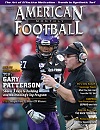Article CategoriesAFM Magazine
|
Turf Trends© More from this issueChances are very good that your team has either installed a synthetic turf field at your facility or played at least one road game on a turf field. Each year, hundreds of football practice and game fields are converted from natural grass to synthetic turf. That’s not surprising, considering that today’s turf systems provide safe, consistent, all-weather playing surfaces that can be utilized 24/7 by not just the football team but by a long list of other sports and activities. What are the specific benefits of synthetic turf fields from playability, safety, environmental and economic standpoints? If you’re interested in having a synthetic turf field installed at your facility, what are the most important things you need to know? To find out, AFM asked industry leaders FieldTurf President Eric Daliere, ....The full article can only be seen by subscribers.
|
|
|||||||
| HOME |
MAGAZINE |
SUBSCRIBE | ONLINE COLUMNISTS | COACHING VIDEOS |
Copyright 2025, AmericanFootballMonthly.com
All Rights Reserved





